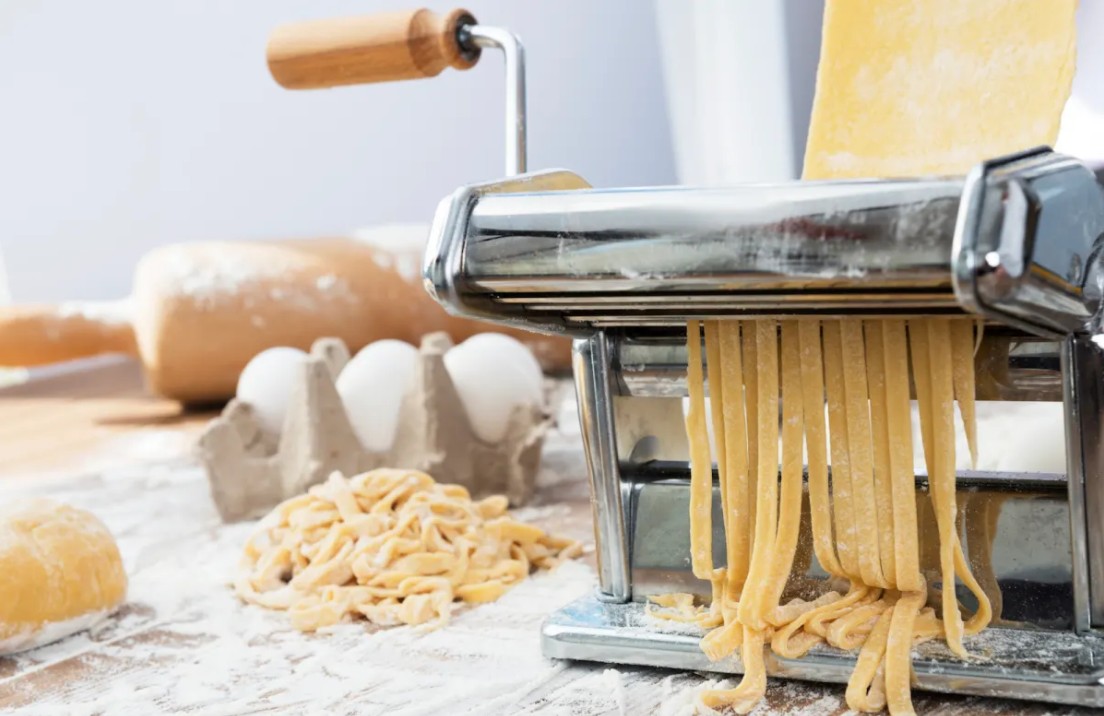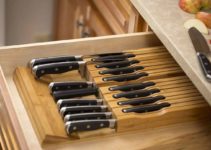How To Use a Pasta Machine?
Table of Contents
So, what else can you use a pasta maker for? As you can probably see from the above list, there are a number of other things that you could use your pasta maker for. In some cases, if you just want to flatten out a not-so-sticky material, you would probably be better off using your pasta maker to do the work for you.
What can you do with your pasta machine after you have finished making your noodles? If you find that it is empty, all you have to do is put it in the dishwasher. This will help it make one more trip through the dishwasher before you throw it away. If your pasta maker has a second bowl that it can be placed in, that is even better because you won’t have to go through the same process when turning it off and on again.

Why Buy A Pasta Maker?
Why buy a pasta maker? Making your own pasta guarantees that your favorite homemade pasta isn’t messy. Making pasta is actually very easy and there’s no need to hire a chef to make it for you. Also, homemade pasta is much more nutritious than making your own pasta from store bought products and that’s why most people prefer to make pasta from scratch than using pre-packaged products.
There are many different types of pasta machines on the market today and all of them serve different purposes. The most common pasta-making machine is the pasta maker that cooks the noodles in a spiral shape. This is achieved by pouring the water into the pasta maker, turning the handle and watching as the noodles start to form. Automated pasta machines are typically more expensive than manual ones, but they save you time and labor as it requires only one person to operate it.
Another type of pasta maker is a roller pasta maker, which is used with a wooden roller that rolls the dough to the desired thickness. Rollers are ideal for making fresh pasta and since the holes are large, the pasta sheets come out looking crisp and ready to serve. Automated roller pasta machines are typically more expensive than manual ones but you’ll save a lot of time if you make pasta from this type of machine. It comes down to personal preference but if you don’t like to do a whole bunch of noodles manually then one of these would probably be your best bet. Manual roller machines usually come in smaller sizes and some don’t have rolling wheels so they may not be ideal for beginners.
Pasta machines come in various sizes and styles. Whether you need them for dinner plates or commercial settings, there are different types of manufacturers. Italian manufacturers dominate the market but you can find other brands that produce good quality pasta. The last thing you want to do is buy the cheapest one you can find, it’s unlikely to last through long enough to make a substantial difference in your profits. As a consumer, it’s important that you go with the company that offers the best pasta makers because you wouldn’t buy an air conditioning unit that won’t do the job. You want something durable that will last you for years while providing you with delicious meals that will keep you coming back for more.
There are two main types of pasta makers you will find. You can buy a hand crank or hand wheeled device and each machine has their own advantages and disadvantages. If you’re only using the machine for a certain limited amount of time each day or if you don’t plan to use it very much then it would probably be easier to choose a wheeled machine. Hand cranked machines on the other hand are extremely versatile and can be used for a variety of uses. Whether you’re preparing meat, pasta, rice, or anything else, there is a pasta maker that will fit your needs.
The newest addition to the pasta maker family is the wellness 150 pasta machines. Health conscious consumers have been looking for ways to make their lives a little easier and the wellness series of machines has just what they are looking for. These machines combine the power of both a pasta maker and a cookie cutter so that you can make the pasta dough right in the bowl of your machine. If you like a bit of pasta dough in your lasagna or if you simply like the idea of cutting it out of shapes, this is the pasta dough machine for you.
Another new pasta maker on the block is the pasta roller. This is basically a larger version of the old fashioned roller that you would use to cut the dough in the early days. Instead of manually rolling the dough by hand, this machine does all of the work for you. All you have to do is load the dough roller with the dough and turn it on. Then once the roller is ready, all you have to do is put the noodles in, start the rotational motion, and pretty soon you will have homemade fresh tasting pasta.
So now that you know what each pasta maker can do, all that remains is to decide which one to buy. There are some obvious choices but the main considerations include price, convenience, and the quality of the machine. Of course, if you don’t mind spending a few extra dollars, you can find a great deal on a pasta maker that has many different features. However, if you are looking for a machine that can produce the kinds of noodles you usually buy in a restaurant, then the budget should be sufficient.
Electric Pasta Maker vs. Manual Pasta Maker
- Electric Pasta Maker
There are two schools when it comes to cooking pasta: those who like the versatility and convenience of electric pasta machines and those who like the more controlled, true-to-life experience you get from a manual crank pasta maker. Electric pasta machines work by quickly extruding the pasta dough with the assistance of a manual motor, taking you less time than you might think to cook the dough. On the other hand, a manual pasta maker allows you to control the speed at which the dough is extruded and, as a result, cooks the pasta with much more control.
Both types of machines come in a wide range of different sizes. They also come in a wide range of different price ranges. If you’re on a budget but want the quality of machines like the ones Ben Kenwood manufactures, you should consider getting a manual machine instead of an electric one. Manual pasta machines can be rather inexpensive, depending on the brand name and quality of the machines. For someone who is still in the process of choosing a pasta maker, or who simply doesn’t have the money for one yet, an electric pasta maker may just be what you need.
So, why should you choose an electric pasta maker over a manual one? The main reason is that you’ll have the ability to control the exact amounts of ingredients, allowing you to create the most delicious homemade pasta dishes imaginable. Simply put, many of the recipes you find in cookbooks and Italian restaurants require varying amounts of ingredients. You wouldn’t have the right texture and flavor if you used all of the ingredients the recipe calls for and having to use too much pasta or too little sauce or cheese leaves your food uneven.
Most electric pasta makers allow you to change out the dough based on what type of recipe you are working with. For example, you can use it to make fresh homemade bruschetta shells for a big party, or you can use it to make wheat germ oatmeal breadcrumbs for breakfast. With a manual machine, you would get stuck changing out the ingredients because there simply aren’t any that are customized. Even if you bought the machine specifically to make breadcrumbs, you still wouldn’t know how to clean it properly, and chances are that it could become infected with salmonella quite easily.
The other benefit of these types of machines is that you don’t have to manually feed the dough into the roller, which is a very time consuming task. All you have to do is set the settings for the thickness of the dough and the speed at which it will be cooked. Once you do this, all you have to do is plug in the electric pasta maker to the wall and turn it on. As soon as you put the ingredients in the hopper, the machine begins to whirl around, making sure to cook the pasta at the proper temperature. The reason it works so well is that the attachment has been designed to be sturdy enough to handle the amount of ingredients that are included on the countertop attachment.
Since it only uses one setting for all different types of recipes, it is much more likely to give you consistent results no matter what type of recipe you are working with. For instance, with a regular pasta maker, the process of mixing and kneading the dough is quite lengthy, and it can also get messy. However, since the attachment has been designed with an elongated design and extra-deep pockets to help with mixing and kneading, the process goes by much faster.
One thing you should definitely look for in a good pasta maker is an easy to clean one. Most of them are dishwasher safe, but one helpful review pointed out that this is not always the case. If you own one made by Eureka, you will need to take special care to wash yours after each use. To wash yours safely, set the machine to delicate settings, run the water cycle, and do not scrub the machine harshly. A gentle cleanser is probably the best choice for this type of homemade pasta maker to make sure it remains clean over time.
To use your new homemade pasta maker, simply mix together the ingredients, spread them out onto the dough, and run the machine to dry them. Then, preheat your oven and cook your homemade pasta according to the instructions on the package. Once done, let your pasta cool, and enjoy your fresh pasta with homemade sauces or top choices. The best part is, you did all of this without using a ton of electricity!
- Manual Pasta Maker
What would you say if I told you that YOU could make your own fresh pasta from scratch using only a Pasta Maker? Would you be interested? Would you want to know more? After all, making pasta the old fashioned way (for generations) was always that much time consuming, and boring, no matter how good the recipe was. Then along came the idea to mix all the different ingredients together to form one big dish out of the mixture, and baking the whole thing. This was way more time consuming and tasted nothing like the homemade stuff that people back in the olden times had made.
So the question remains – Is a Manual Pasta Maker the right tool for you? How come this all happened? How can a simple dough hook from KitchenAid fit into your busy schedule? Well, let me explain.
The Pasta Maker has a built in motor that makes the process quick and simple. You simply throw the dough in and mix it until it looks ready to work, and then give it a little tap on the bottom to seal it. Then you just turn the machine on, and your pasta comes out of the mixer in just minutes. There are three different types of machines – the roller, the spiralizer, and the plain old manual hand crank.
Let’s look at some of the different types of machines available to you, so you can decide which one is right for you. First, let’s look at the roller. There are many different models of KitchenAid roller machines. The most well rounded one for beginners would be the Cuisinart Artisan Roller with their interchangeable wooden and plastic dough rollers. These have a handle that makes it very easy to operate, a long handle to reach high places, and solid construction so the cutters don’t stick when you are rolling out dough.
There are also KitchenAid pasta maker machines with other types of attachments. For example, there are the Artisan Roller with both short and long handles, the Cane Router, the Spiralizer, and even the H-Frame. And, if you want to get serious with making pasta, you might consider one of the many different types of machines that make pasta with wooden bowls. This includes the Imperia pasta bowls, the Vermiculture Spatula, the Tortellini Spatula, and the Bello Italian Spatula. Each of these machines can handle both fine and coarse flour, pasta, eggs, nuts, seeds, and oils.
Another great brand that offers both manual pasta maker and electric version is the Amazon Iron Cooker. The electric version can cook stews, soups, sauces, chili, and chilis and the manual one can cook lasagna, casseroles, and flatbreads. The Amazon Stainless Steel Pasta Maker is made by Amazons, which is known worldwide for the quality of its products. If you are looking for a quality machine that is reasonably priced, this is a great brand to consider.
For something with a little more style, you might want to look into some of the Italian-made pasta makers. There are several different styles, including those that come in wood and metal cases, those made from all wood and all metal, and those that come in only one case made from metal. With Italian-made products, you know that they will be durable and of high quality. In addition, most Italian pasta makers will include a pasta setting, which allows you to choose the texture, dough, and salt for your desired taste. You will also find that most Italian pasta makers will have a non-stick or non-rubber paddle that helps make the process simple and easy.
With so many brands available, you should have no problem finding the perfect pasta maker for your kitchen. Remember though, not to settle for any old pasta maker, because even the best pasta makers sometimes fail you. Do your research, check out reviews, and consider price, features, and size before choosing a kitchen aid appliance for your home. The only thing that you should never do is let a cheap product defines what you should not put into your body! So choose your new pasta maker wisely, enjoy making fresh, delicious meals, and eat better than you ever have before!
How To Use a Pasta Machine
You may already have a pasta maker in your kitchen. If not, you should consider getting one. They make the job of mixing together your favorite pasta ingredients much easier. There are even automatic ones these days that mix your dough and distribute it into proper shapes. It’s worth the investment!
How To Use a Pasta Machine, Part I: Pasta dough. First, you should always have fresh, live, dough in your kitchen. If not, start with a whole wheat flour or all purpose flour. This type of flour has a very fine texture that will really work well when kneading your own dough. Of course, you can always buy pre-made dough from the grocery store or order one online. As long as you have some pasta dough in your cupboard, you’re ready to get started.
How To Use a Pasta Machine, Part II: Choosing Your Pasta. First, you should choose what kind of pasta you want to make. There are tons of different types, including linguine, rigatoni, casserole, and many others. You can also choose from a variety of different recipes. For instance, if you want to cook an alfredo sauce for a chicken dinner, then use the whole grain semolina flour.
How To Use a Pasta Machine, Part III: Getting Your Pasta Dough In The Right Form. Second, you should make sure to mix the dough by hand until it’s fully developed. Although most pasta makers come with a built-in mix, it’s still best to manually mix your dough. This ensures that the ingredients have a good hold together.
How To Use a Pasta Machine, Part IV: Using Your Pasta Maker. Third, it’s best to use your pasta maker immediately after preparing the recipe. Some of the ingredients may be stale by the time you try to bake them. So it’s best to make fresh pasta right away. This way, you won’t have to wait for hours or days just to have your favorite recipe baked into your special meal.
How To Use a Pasta Machine, Part V: Cleaning The Determinate Parts. After using your pasta maker, it’s important to take care of the parts and the entire machine. First, take note that the motor is usually located on the bottom or side. It’s a good idea to clean this part with a damp towel.
How To Use a Pasta Machine, Part VI: Feeding the Dough Properly. Now that you’ve used your pasta maker, you have to feed it the right amount of dough. This way, the roller will do its job properly. Just like any manual device, the roller has to be turned on its side or rotated 90 degrees.
How To Use a Pasta Machine, Part VII: Caring for Your Pasta Machine. If you want to bake homemade pasta from scratch, then you need to keep your pasta maker in good condition. You should have a cleaning tool as part of your kitchen equipment. It’s a good idea to invest in a stainless steel tool, since it’s durable and can withstand heavy objects in the food preparation process. Also, it’s important to regularly clean your pasta maker so that dirt doesn’t accumulate inside.
How To Use a Pasta Machine, Part VIII: Getting the Results You Want. Once your pasta maker is ready, you can start cooking. This means that you need to set the device to the desired cooking setting. The manufacturer may even recommend a certain setting if you want to get the best pasta maker.
How To Use a Pasta Machine, Part IX: Making Fresh Noodles When your noodles are ready, it’s time to cook them. This involves feeding the noodles with the correct amount of water, extra dough, and oil. Most pasta makers come with a pasta dough hook, which lets you turn the noodles in the right direction, resulting in fluffy, yet thin noodles.
How To Use a Pasta Machine, Part X: Bringing the Dish to Life. Once the noodles are fully cooked, all you have to do is cook them on the top rack of the pasta maker. You can then load them into the strainer and serve. After they cool, you can scrape the insides of the noodles with a knife to reveal the delicious, soft, and fresh inner noodles.
Conclusion
Once you have made sure that your pasta maker is clean, all that remains is to add your own desired mixture to the hopper. Most people will manually put the ingredients into the hopper, but if you are pressed for time, you might find yourself using the feeder instead. Feeding the dough through the pasta maker is very easy and once you have it where you want it, carefully cover it with the floured cloth and turn it on. After five minutes or so, your delicious homemade dough should be ready. Then just wait a couple of minutes before removing it from the pasta dough hook and you are all set!


